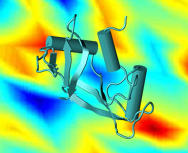Summary
Our goal is to address critical measurement issues that exist regarding chemical and physical stability of biomacromolecules (proteins and DNA) in hydrophilic, hydrogen-bonding glasses such as those used in the biopharmaceutical industry. The analytical methods and theory that is developed in addressing these needs will lead to rational formulation of stabilizing glasses, facilitate stabilization of promising but unstable drug candidates, as well as shed light on the physical processes that lead to glass relaxation phenomenology.
Description

This project is an integral part of a cooperative effort – led by NIST, and partially funded by NIH/NIBIB – which includes the University of Wisconsin, the University of Colorado, and the University of Connecticut. We use the following approach to develop measurement solutions for biopharmaceutical stabilization: 1) Use theory, simulation and experimentation to develop clear understanding of key relationships between glass properties and likely stability outcomes of proteins in the glasses. 2) Develop analytical methods to unambiguously and precisely measure the glass properties of interest. 3) Validate the theoretical models by carrying out stability studies of model compounds and of pharmaceutically important proteins in fully characterized hydrophilic glasses.

Major Accomplishments
In 2004 we showed for the first time that the amplitude of local, high-frequency motions (on ns timescale, and Angstrom lengthscale) in hydrophobic glasses are key indicators of protein stability within those glasses. Previous to this work, alpha relaxation in glasses was used as the sole measure of stability-related dynamics.
Since then we have shown that the impact of these high-frequency motions can dominate over all other measured properties in determining chemical and physical protein stability deep in the glassy state.
Fluorescent Probe for Hydrogen Bond Network Lifetimes
We demonstrated that hydrogen bond network dynamics in glassy materials greatly impacts stability of proteins stored in those materials. Stability of sequestered proteins is of paramount importance when considering safety and efficacy of cytokines in biodegradable tissue scaffolds. Heretofore methods such as neutron scattering and dielectric spectroscopy have been used to measure these dynamics. We have recently demonstrated that a simple fluorescent probe can be used to reliably probe these dynamics. The ease of use and amenability to spatially-resolved measurements will allow us to develop characterization approaches for tissue scaffolds, and high-throughput formulation methods for use in the bio-pharmaceutical industry.
Project Summary (PDF)

